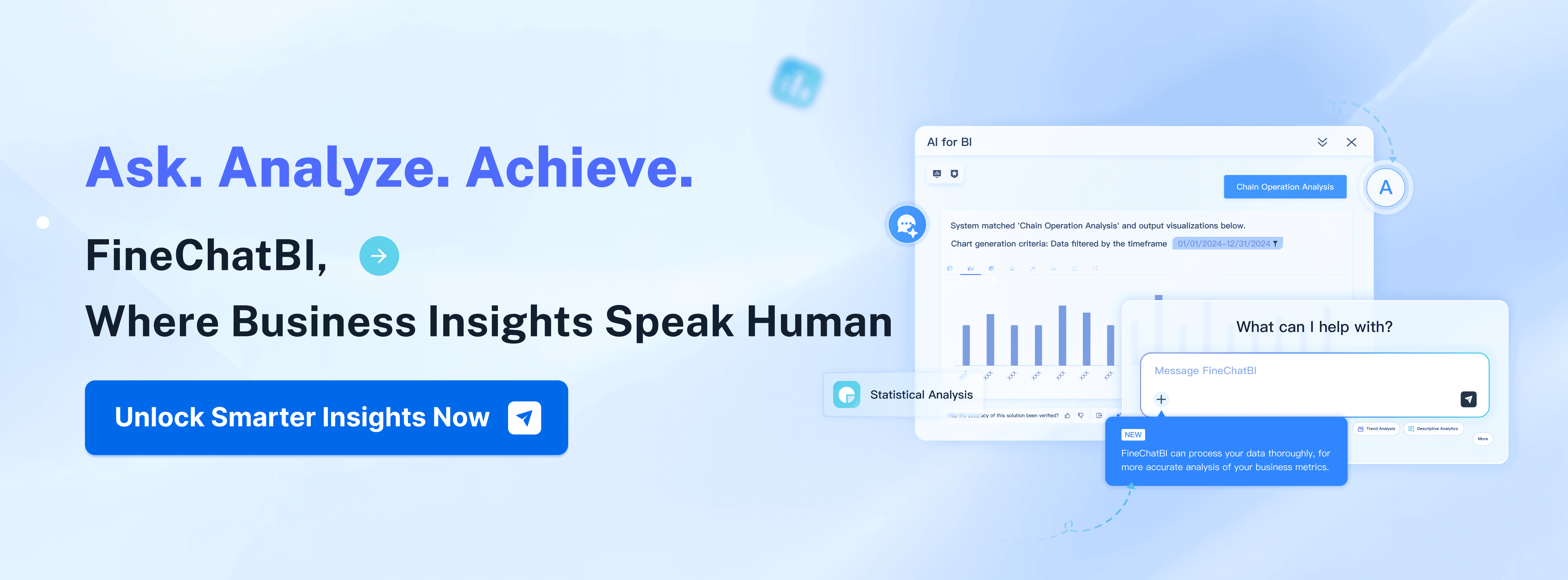Big data in the age of AI creates new opportunities for you to drive business innovation and make smarter decisions. AI advancements have changed how you work with big data, providing faster and more accurate insights. You can see this shift in the numbers:
| Statistic | Value |
|---|---|
| Organizations using AI | 78% (up from 55% in 2024) |
| Private investment in AI (2024) | $252 billion |
| Investment in generative AI | $33.9 billion |
| U.S. AI investment | $109.1 billion |
| CAGR forecast (2025-2030) | 35.9% |
| Healthcare AI adoption CAGR | 36.8% |
| Manufacturers using AI | 77% (up from 70% in 2024) |
You need strong data integration, real-time analytics, and AI-driven insights to stay ahead. Artificial intelligence helps you understand complex business scenarios and adapt quickly. FanRuan leads in business intelligence and gives you practical tools to leverage ai and big data for better results.
Big Data in the Age of AI: 2025 Trends

The landscape of big data in the age of AI is changing fast. You now see new trends that shape how you collect, process, and use data. These trends help you unlock more value from your data and drive business innovation.
Real-Time Data Integration
You need to make decisions quickly. Real-time data integration lets you connect and synchronize data from many sources in milliseconds. This approach helps you respond to changes as they happen. The market for real-time data integration is growing rapidly. You can see this growth in the numbers:
| Statistic Description | Value |
|---|---|
| Market Growth | From $15.18 billion in 2024 to $30.27 billion by 2030 |
| Average ROI | 295% over 3 years, with top performers at 354% |
| Customer Experience ROI | 633% over 3 years, with $38.4 million in benefits |
| Profitability | Data-driven companies are 6% more profitable than competitors |
You can use platforms like FanRuan's FineDataLink to integrate data from over 100 sources. FineDataLink helps you break down data silos and build a strong foundation for big data analytics. With real-time synchronization, you can support business operations, improve customer experiences, and boost profitability.
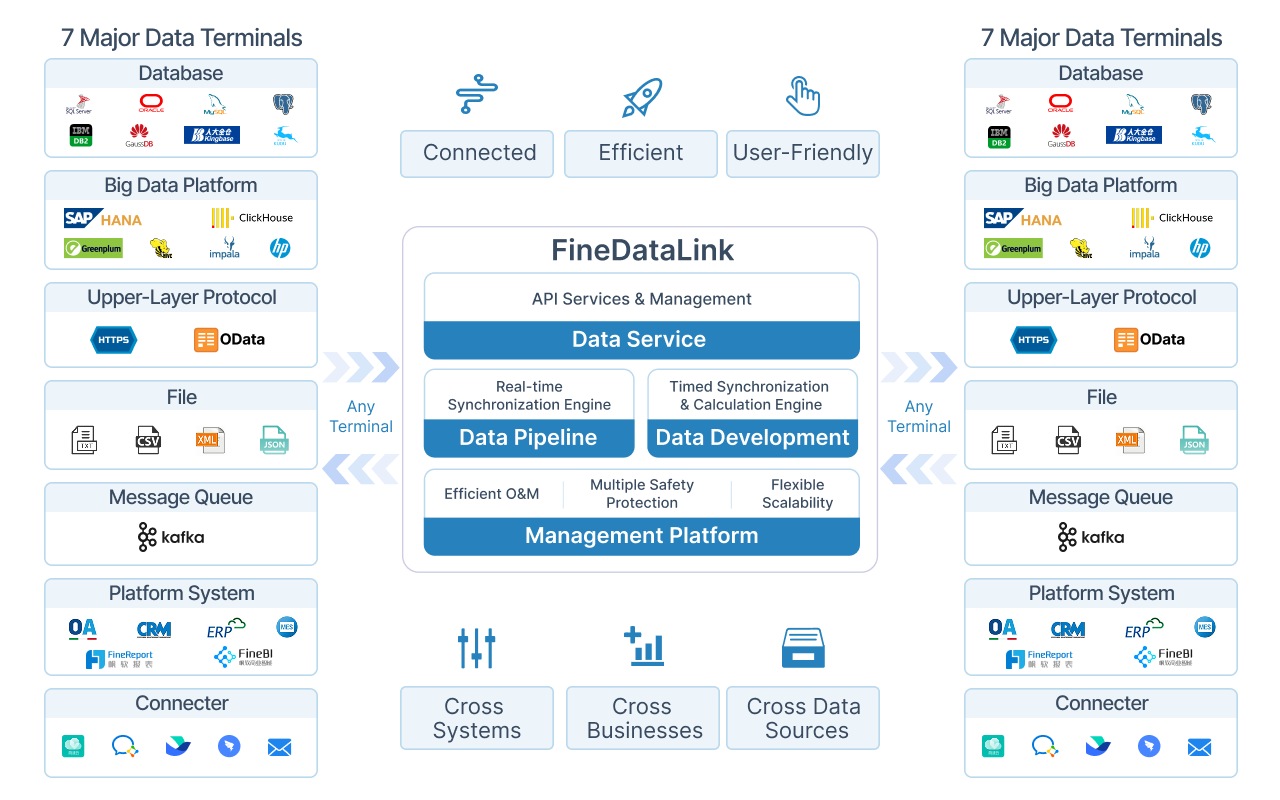
AI-Driven Automation
AI and big data work together to automate many tasks that once took hours. You can now use AI to collect, classify, and validate data without manual effort. This automation improves data quality and speeds up your workflow. Here are some common use cases for AI-driven automation in big data environments:
| Use Case | Description |
|---|---|
| Data Ingestion | Automates the process of collecting and importing data from various sources into a data system. |
| Data Classification | Uses AI to categorize data into predefined classes for easier management and retrieval. |
| Data Validation | Ensures the accuracy and quality of data by checking for errors and inconsistencies. |
| Data Quality Improvement | Identifies anomalies, duplicates, and incomplete records to enhance overall data reliability. |
| Data Integration | Recognizes relationships between diverse data sources, facilitating faster connections. |
| Data Governance | Automates tracking of data usage and compliance with regulations, ensuring data integrity. |
You can see how the integration of big data and AI enables faster insights and better decision-making. Augmented analytics, powered by AI, now automates traditional analysis tasks. This shift lets you focus on strategy and innovation instead of manual data work.
Edge Computing Impact
You process more data at the edge than ever before. Edge computing brings data processing closer to where data is created. This trend reduces delays and supports real-time analytics. By 2025, 75% of enterprise data will be processed at the edge. AI and machine learning integration at the edge has grown by 335%. Cloud-native architectures now have a 90% adoption rate.
You benefit from edge computing in many ways. In healthcare, claim processing times have dropped by 40%. In finance, instant portfolio monitoring prevents million-dollar losses. You can use edge computing to support AI and big data projects that need fast, local decisions.
Data Privacy and Ethics
As you use more big data and AI, you face new privacy and ethical challenges. You must protect sensitive information and ensure fair use of data. Common challenges include inadequate testing, limited documentation, and insufficient monitoring. Algorithmic bias and unauthorized data usage also create risks.
| Challenge | Description |
|---|---|
| Inadequate testing | Many organizations deploy AI systems without comprehensive evaluation against safety benchmarks. |
| Limited documentation | Critical information about data sources and risks often remains undocumented. |
| Insufficient monitoring | Deployed systems often lack robust monitoring for performance or unexpected behaviors. |
| Siloed responsibility | AI governance remains disconnected from broader security and privacy functions. |
| Algorithmic bias | Leading AI systems continue to exhibit biases that reinforce stereotypes. |
| AI-driven misinformation | The rise of AI-generated misinformation poses risks to data integrity and brand protection. |
| Unauthorized data usage | Data is often used or collected without proper consent. |
| Biometric data concerns | The use of biometric data raises privacy issues, especially regarding consent and misuse. |
| Covert data collection techniques | Many AI systems collect data quietly, leading to privacy breaches and ethical concerns. |
| Bias and discrimination in algorithms | Algorithmic bias can lead to discrimination, requiring robust accountability measures. |
You can address these challenges by following best practices:
- Conduct a comprehensive AI risk assessment.
- Implement data governance controls.
- Adopt privacy-by-design approaches.
- Develop continuous monitoring capabilities.
- Build cross-functional governance structures.
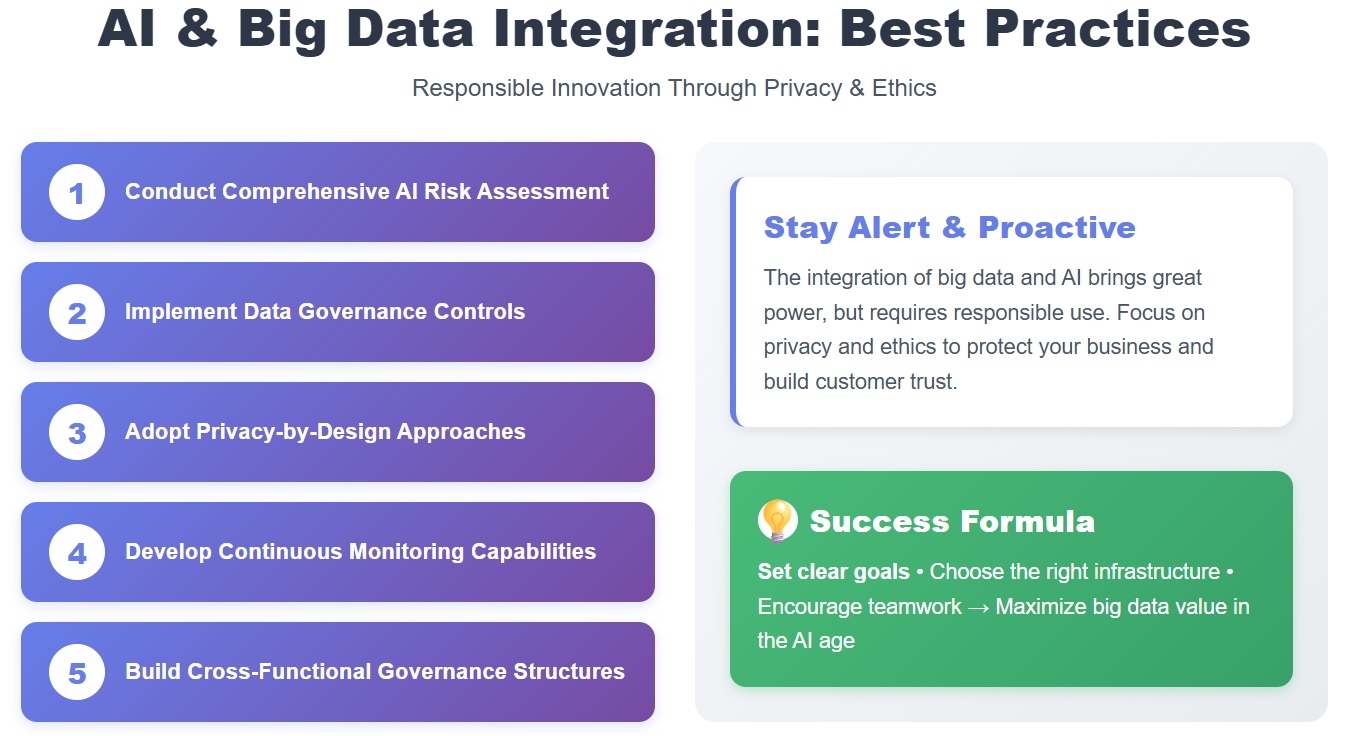
You need to stay alert and proactive. The integration of big data and AI brings great power, but you must use it responsibly. By focusing on privacy and ethics, you protect your business and build trust with your customers.
Tip: Set clear goals, choose the right infrastructure, and encourage teamwork. This approach helps you get the most value from big data in the age of AI.
Impact of Big Data on AI Innovation
Big data in the age of AI drives rapid changes in business innovation. You see the impact of big data every day as organizations use AI and big data to solve complex problems and unlock new opportunities. The relationship between AI development and big data is strong. AI techniques for big data help you analyze massive datasets, uncover patterns, and make smarter decisions. Machine learning and big data work together to fuel ai innovation and support business growth.
Enhanced Decision-Making
You rely on big data to improve decision-making. AI development uses large volumes of data to learn, adapt, and deliver accurate insights. When you combine AI and big data, you gain the ability to process information in real time. This approach helps you spot trends, identify risks, and respond quickly to market changes.
- Big data analytics uncovers trends, patterns, and correlations in large volumes of raw data, which enhances AI's ability to make informed decisions.
- AI algorithms process substantial amounts of data in real time, improving the speed and efficiency of decision-making.
- AI tools identify hidden patterns in complex datasets, revealing market trends that can significantly impact business decisions.
- The relationship between AI and big data is symbiotic, with AI requiring large volumes of data to enhance decision-making capabilities.
- Effective analysis of big data leads to valuable insights into customer preferences and interactions, which are crucial for informed business decisions.
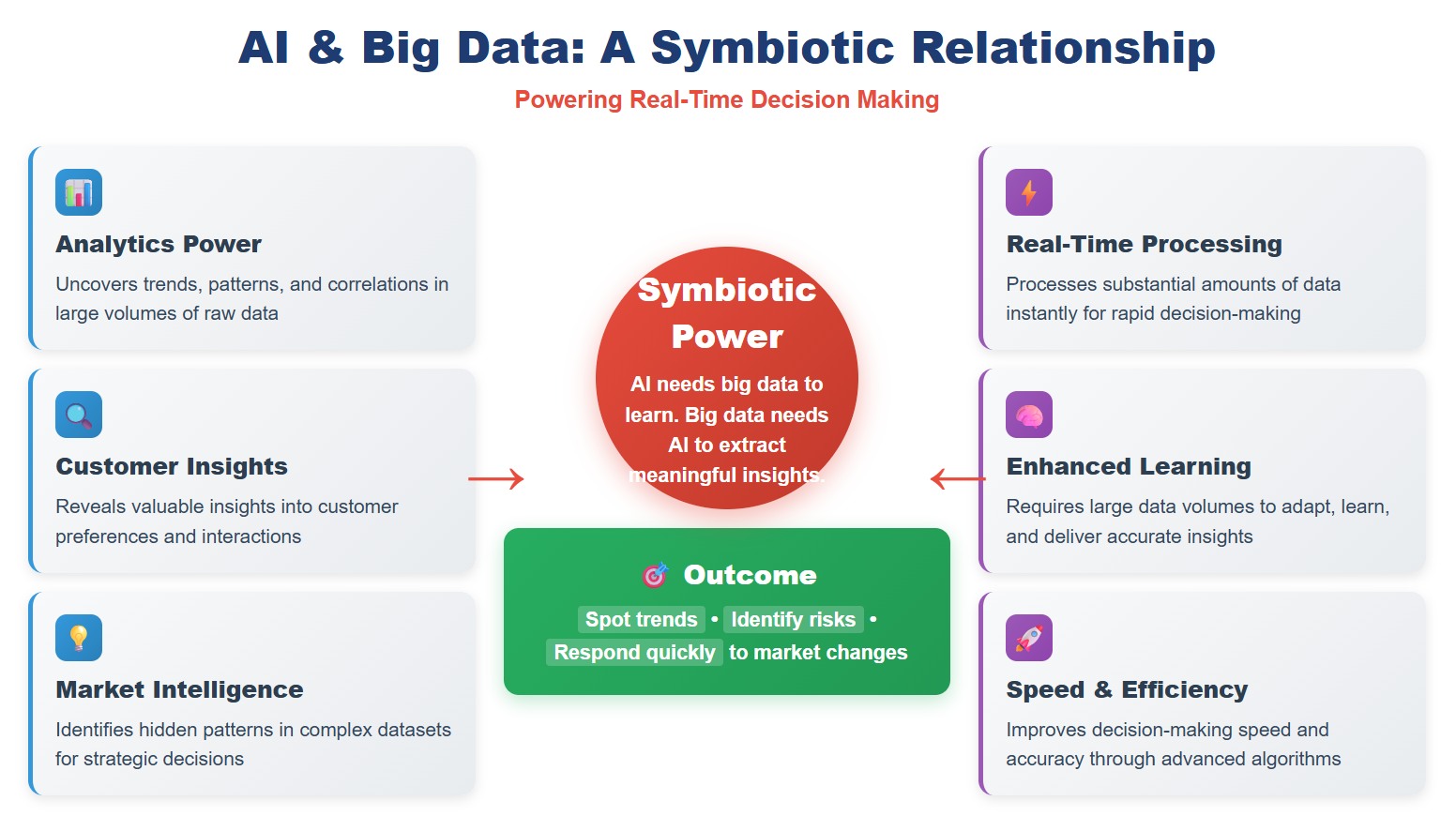
FanRuan’s FineChatBI empowers you to interact with data using natural language. You ask questions and receive instant answers, making data-driven decisions easier. FineChatBI combines conversational analytics with business intelligence, helping you interpret complex data and act with confidence.
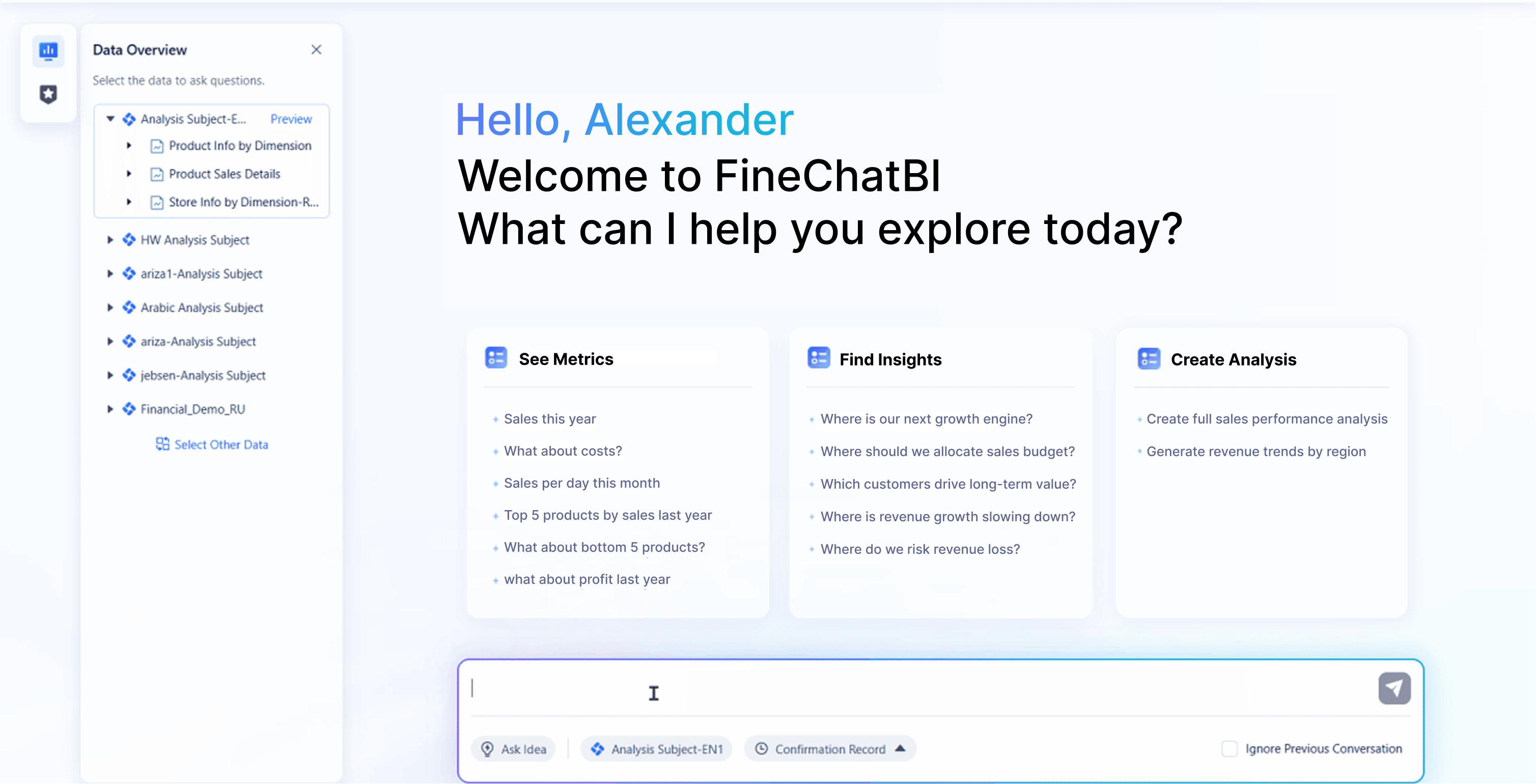
Predictive Analytics
Predictive analytics transforms how you plan and operate. AI and big data work together to forecast outcomes, detect anomalies, and optimize resources. You use predictive models to anticipate future events and minimize risks.
- Predictive maintenance in manufacturing helps you reduce downtime and lower costs.
- Real-time fraud detection in finance uses behavioral analytics to enhance security.
- Forecasting demand and optimizing inventory improves supply chain and logistics.
- Healthcare organizations use predictive analytics to forecast patient deterioration and treatment outcomes.
- Retailers apply hyper-personalized recommendations and dynamic pricing strategies to boost sales.
With predictive analysis, you can use strategic leadership, basing your decisions on real data instead of gut feelings.
Event-driven architectures and data-in-motion platforms, such as Apache Kafka and Apache Flink, process streaming data in real time. These systems allow predictive models to detect anomalies and forecast trends instantly. FanRuan’s FineChatBI supports predictive analytics by providing real-time insights and actionable recommendations.
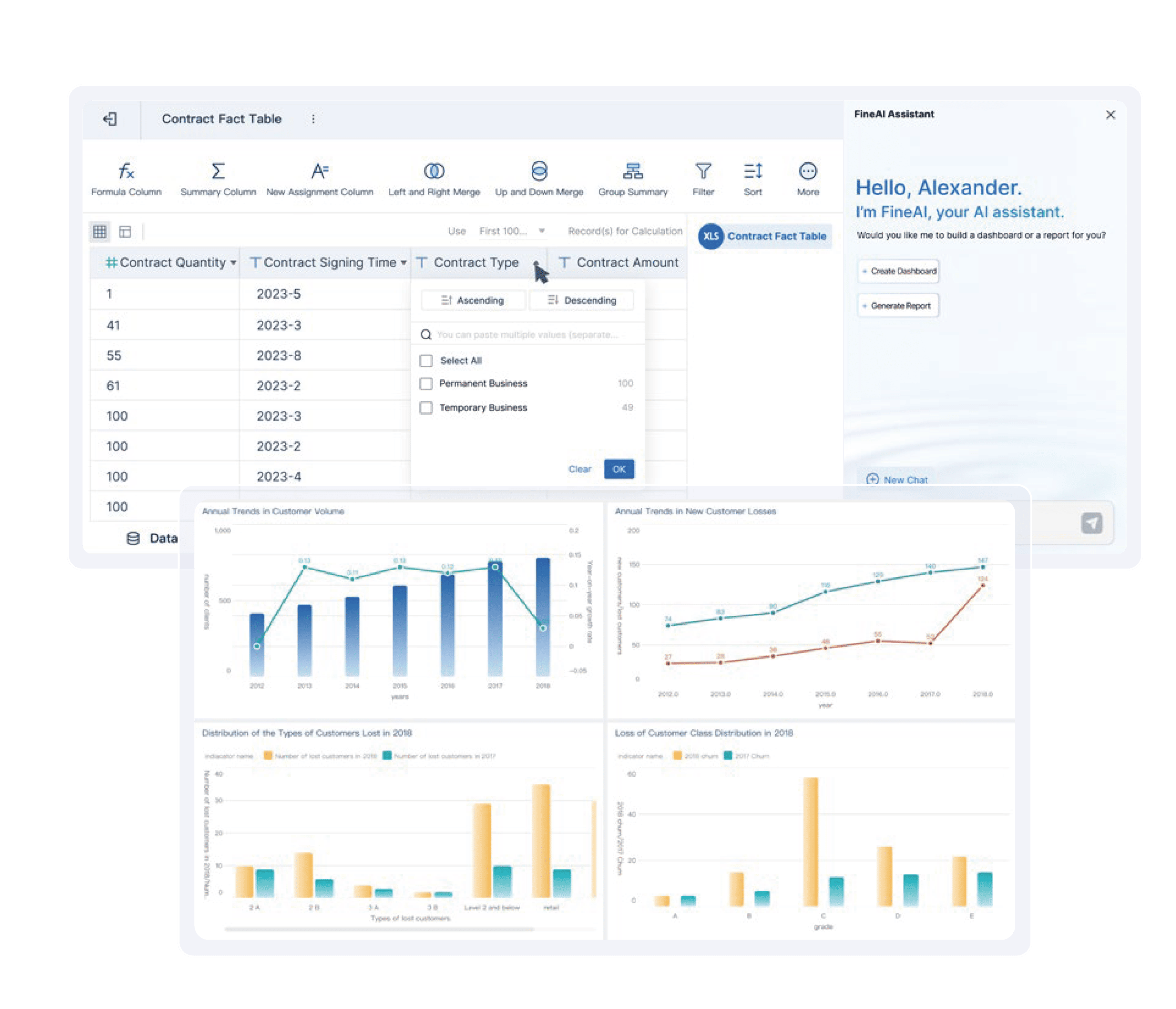
Personalized Experiences
You expect personalized experiences in every interaction. AI and big data enable organizations to tailor products, services, and content to your preferences. This transformation creates deeper connections and improves satisfaction.
- Reebok’s homepage customization delivers unique content based on past shopping behavior.
- Nespresso’s personalized content educates visitors with product recommendations and recipes tailored to their past purchases.
- Retail: AI analyzes customer data to provide targeted product recommendations, enhancing customer satisfaction.
- Healthcare: AI creates personalized treatment plans by analyzing medical history and lifestyle choices.
- Banking: Predictive analytics offer tailored financial products based on customer data.
FanRuan’s FineChatBI helps you access personalized insights. You receive recommendations and analysis that match your needs, whether you work in retail, healthcare, or finance. FineChatBI uses advanced AI development to interpret your queries and deliver relevant results.

Operational Efficiency
You improve operational efficiency by integrating big data with AI. Organizations use AI innovation to automate tasks, optimize workflows, and allocate resources more effectively. The impact of big data on operations is clear when you look at measurable outcomes.
| Organization | Improvement Description | Measurable Outcome |
|---|---|---|
| Meta | Focused on AI operational efficiency | 201% net income increase, 178% stock surge |
| Axis Bank | AI voice assistant AXAA handles 12-15% of calls with 90% accuracy | Boosted customer service efficiency |
| Cleveland Clinic | Used AI to optimize operations like patient advice and resource allocation | Achieved a 0.4% operating margin |
| JPMorgan | Drastically reduced time spent on interpreting business credit agreements | From 360,000 hours annually to mere seconds |
You see the impact of big data in the age of AI as organizations achieve faster response times, higher accuracy, and lower costs. FanRuan’s FineChatBI supports operational efficiency by providing instant access to data and automating analysis tasks. You spend less time searching for information and more time driving business innovation.
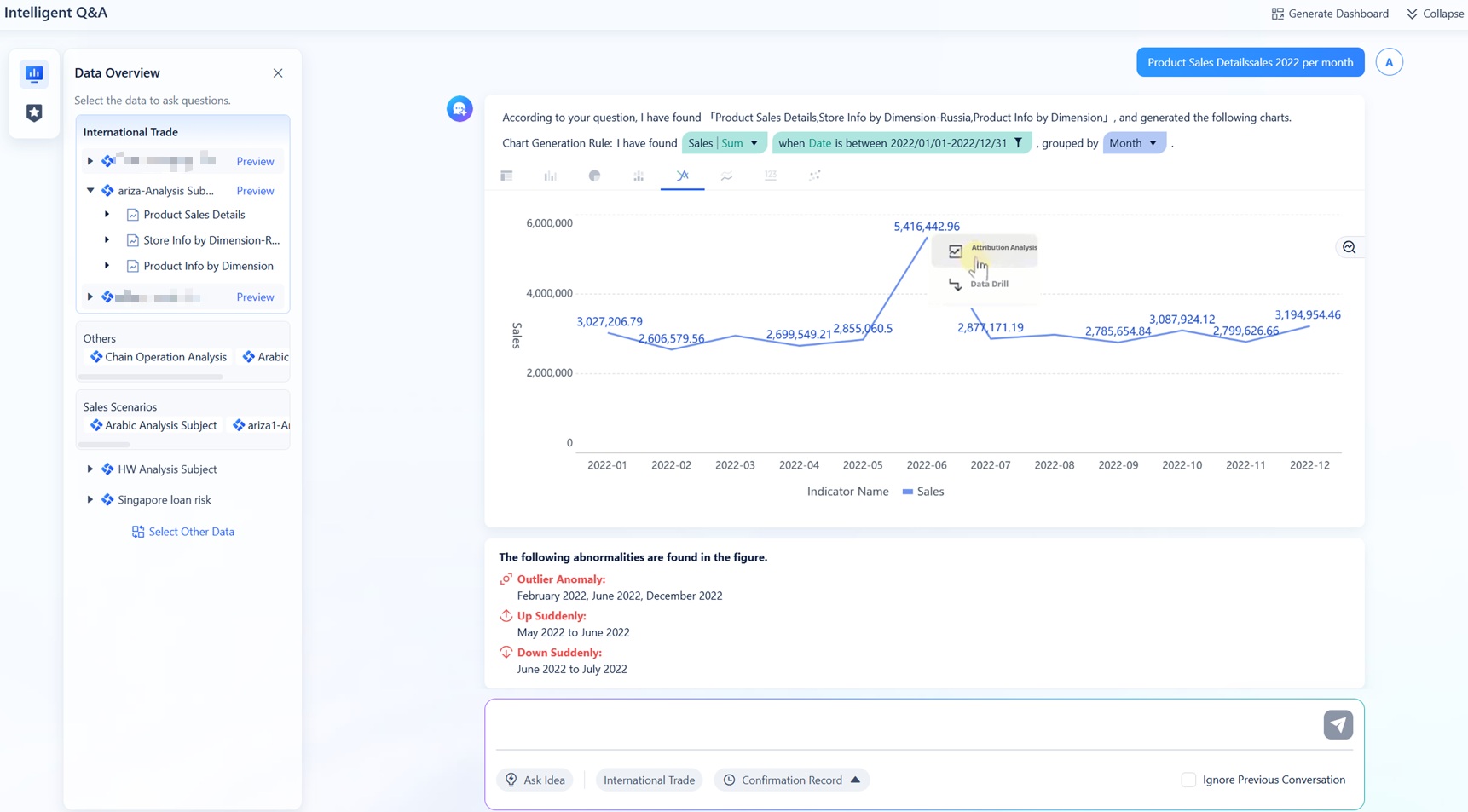
Tip: Use AI techniques for big data to streamline your operations and stay ahead in a competitive market.
The impact of big data on ai innovation continues to grow. You benefit from smarter decision-making, predictive analytics, personalized experiences, and improved efficiency. FanRuan’s FineChatBI gives you the tools to harness the power of AI and big data for lasting transformation.
Use Cases: AI and Big Data in Action

Manufacturing Optimization
You see major changes in manufacturing when you use ai and big data. Companies use these technologies to predict machine failures, optimize workflows, and improve product quality. FineDataLink helps you integrate data from sensors, machines, and supply chains in real time. FineChatBI lets you analyze production data with simple questions. Here is how leading manufacturers use big data and ai:
| Company | Use Case Description | Impact |
|---|---|---|
| Siemens | Predicts machine failures and optimizes workflows | Product quality rate over 99.99% |
| GE | Uses digital twins for real-time performance monitoring | Millions saved, less downtime |
| BMW | Scans car bodies for imperfections in real time | Faster inspections, better quality |
| Foxconn | Automates tasks and manages supply chain logistics | Improved accuracy, fewer defects |
| Unilever | Forecasts demand and optimizes inventory | Less waste, better product availability |
Retail Analytics
You can transform retail operations with ai and big data. FineChatBI helps you understand customer behavior and create personalized offers. FineDataLink connects data from online stores, sensors, and social media. Retailers use big data to track inventory, analyze customer traffic, and monitor brand sentiment.
| Application | Description |
|---|---|
| 360-degree view of the customer | Consolidate customer information to enhance service |
| Real-time brand sentiment analysis | Analyze social media data for accurate sentiment |
| Custom offers | Create promotions based on browsing patterns |
| Customer traffic monitoring | Use sensor data to study shopping behavior |
| Object tracking | Track items on shelves to prevent theft and analyze engagement |
| Inventory management | Optimize supply chain and inventory planning |
| Customer interaction insights | Refine marketing strategies for personalized experiences |
| Customer satisfaction | Enhance relationships for brand loyalty |
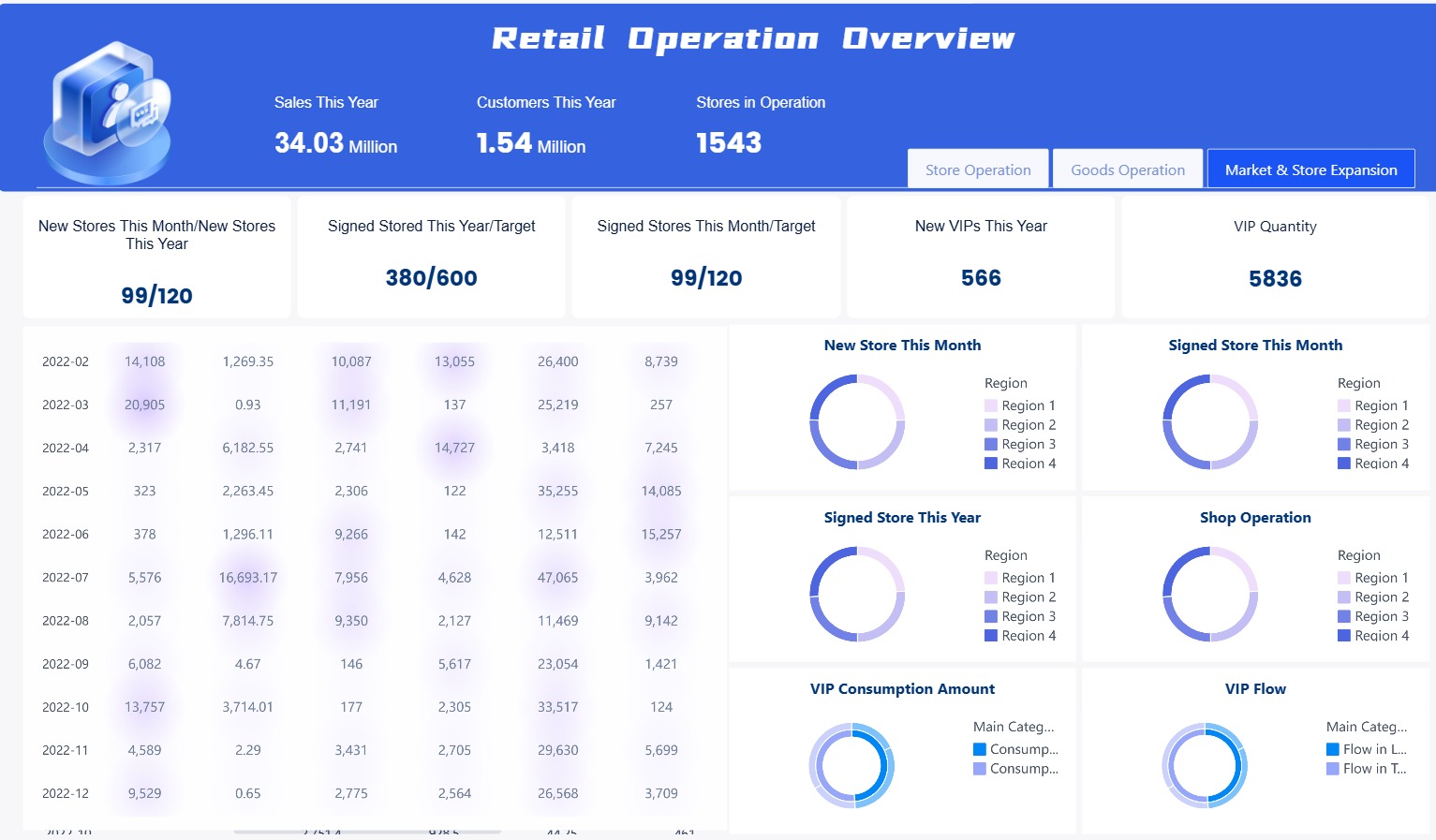
Healthcare Insights
You improve patient care when you use ai and big data. FineDataLink integrates medical records, sensor data, and lab results. FineChatBI helps you ask questions about patient trends and treatment outcomes. You can:
- Provide personalized treatments using data-driven insights.
- Identify patterns in large datasets for better diagnosis.
- Use predictive analytics to reduce hospital readmissions.
- Improve glycemic control in diabetic patients with continuous analysis.

Financial Services Transformation
You see financial institutions change rapidly with ai and big data. FineDataLink connects transaction data, customer profiles, and risk models. FineChatBI lets you analyze fraud patterns and credit risks with natural language queries. You benefit from:
- Fraud detection and prevention using deep learning.
- Enhanced credit scoring for fair lending terms.
- Better risk management with market simulations.
Most financial professionals report higher revenue and lower costs from ai initiatives. You join 92% of U.S. companies using ai for operational improvements.
FanRuan Customer Story: TXC Corporation
TXC Corporation used FanRuan solutions for a full digital transformation. You can see the results in their operations:
| Achievement | Description |
|---|---|
| Comprehensive digital transformation upgrade | TXC upgraded all digital systems |
| Improved data visualization capabilities | Employees use advanced visualization tools |
| Faster and more accurate decision-making | Decisions are quicker and more precise |
TXC used FineChatBI and FineDataLink to democratize data access and improve analytical efficiency. Employees now analyze data easily and make better decisions. You can follow TXC’s example to unlock business value with big data in the age of ai.

Tip: Use FineChatBI and FineDataLink to simplify data analysis and drive innovation in your organization.
Strategies for Leveraging AI and Big Data
Building a Data-Driven Culture
You need a strong foundation to succeed with ai and big data. Start by making sure your organization has quality data that everyone can access. Give your team the skills to interpret big data and use the right technology for smooth operations. Leadership buy-in is essential. When executives support data-driven projects, you see faster progress. Empower all employees to use big data and ai tools. Encourage teamwork between business and technology teams. Define clear goals and measure success with key performance indicators.
- Leadership buy-in
- Data empowerment
- Collaboration
- Value realization
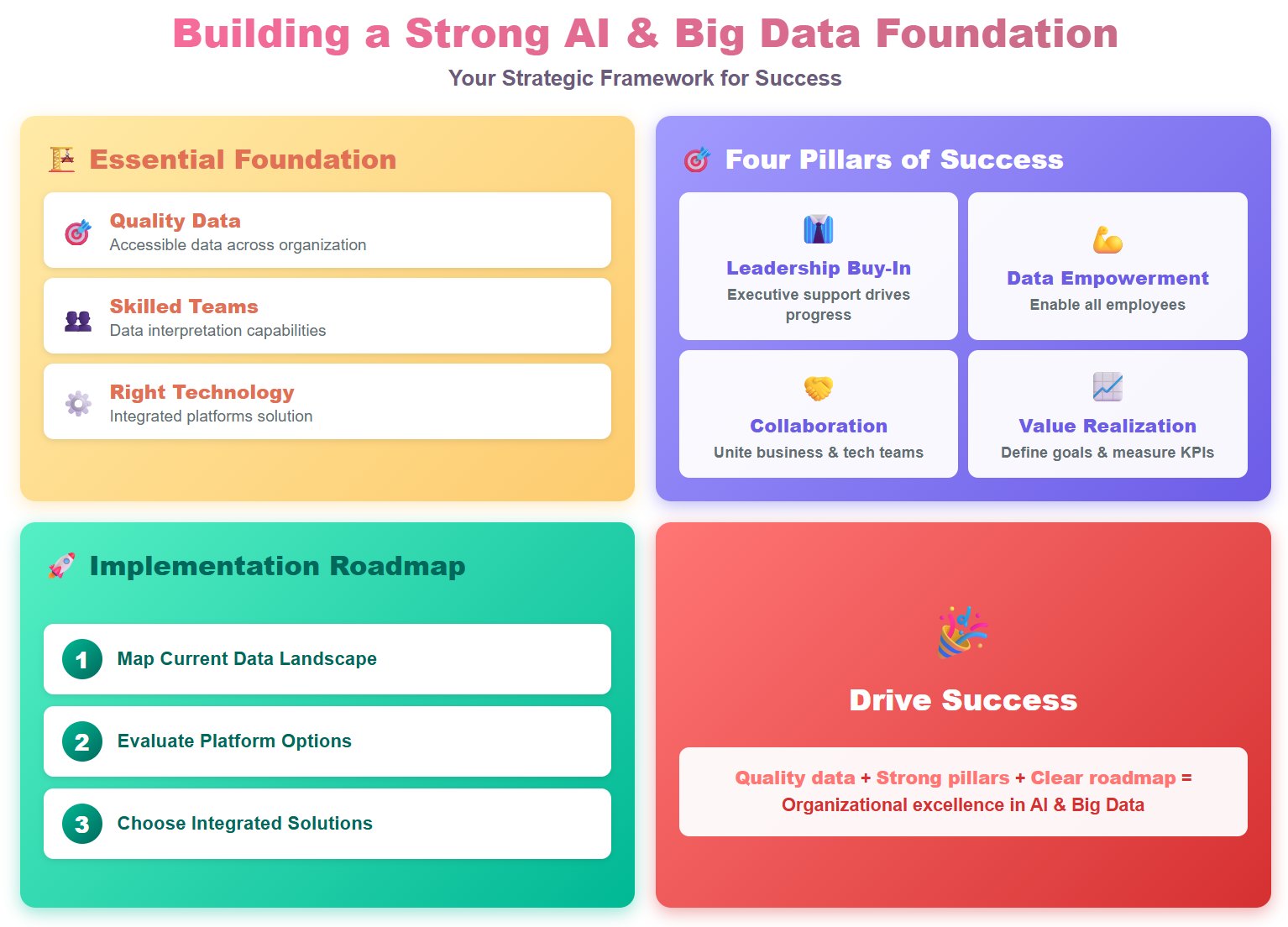
You can map your current data landscape, evaluate your options, and choose integrated platforms to avoid data fragmentation.
Scalable Infrastructure
You need scalable infrastructure to handle big data in the age of ai. High-performance computing helps you manage large ai workloads. Efficient data complexity management keeps your systems running smoothly. Operational governance ensures compliance and policy enforcement. Real-time inference capabilities deliver instant answers to your queries. Unified data intelligence platforms support training, inference, and analytics for ai and big data projects.
| Requirement Type | Description |
|---|---|
| High-Performance Computing | Handles immense computational resources for ai workloads. |
| Data Complexity Management | Manages large datasets and ensures efficient processing. |
| Operational Governance | Ensures compliance and policy enforcement. |
| Real-Time Inference Capabilities | Delivers instant responses with fast storage systems. |
| Unified Data Intelligence Platform | Supports cohesive architecture for ai workloads. |
Collaboration and Upskilling
You achieve better results when you invest in collaboration and upskilling. Structured programs help your team learn both technical and business skills. Personalized mentorship and hands-on learning improve performance. You see higher completion rates and career growth. Encourage teamwork across departments to drive innovation with ai and big data.
- Upskilling programs boost technical and business skills.
- Mentorship and hands-on learning improve employee performance.
- Collaboration leads to innovation and better project outcomes.
Tip: Foster a culture of continuous learning to keep your team ready for new big data and ai challenges.
Data Governance with FanRuan
You need strong data governance to maximize the impact of ai and big data. FanRuan offers solutions that help you manage, integrate, and protect your data. FineDataLink supports real-time data synchronization and ETL processes. You can connect over 100 data sources and build a unified data layer for business intelligence. FineChatBI lets you analyze data with natural language, making insights accessible to everyone. These tools help you maintain data quality, ensure compliance, and empower your team to make informed decisions.
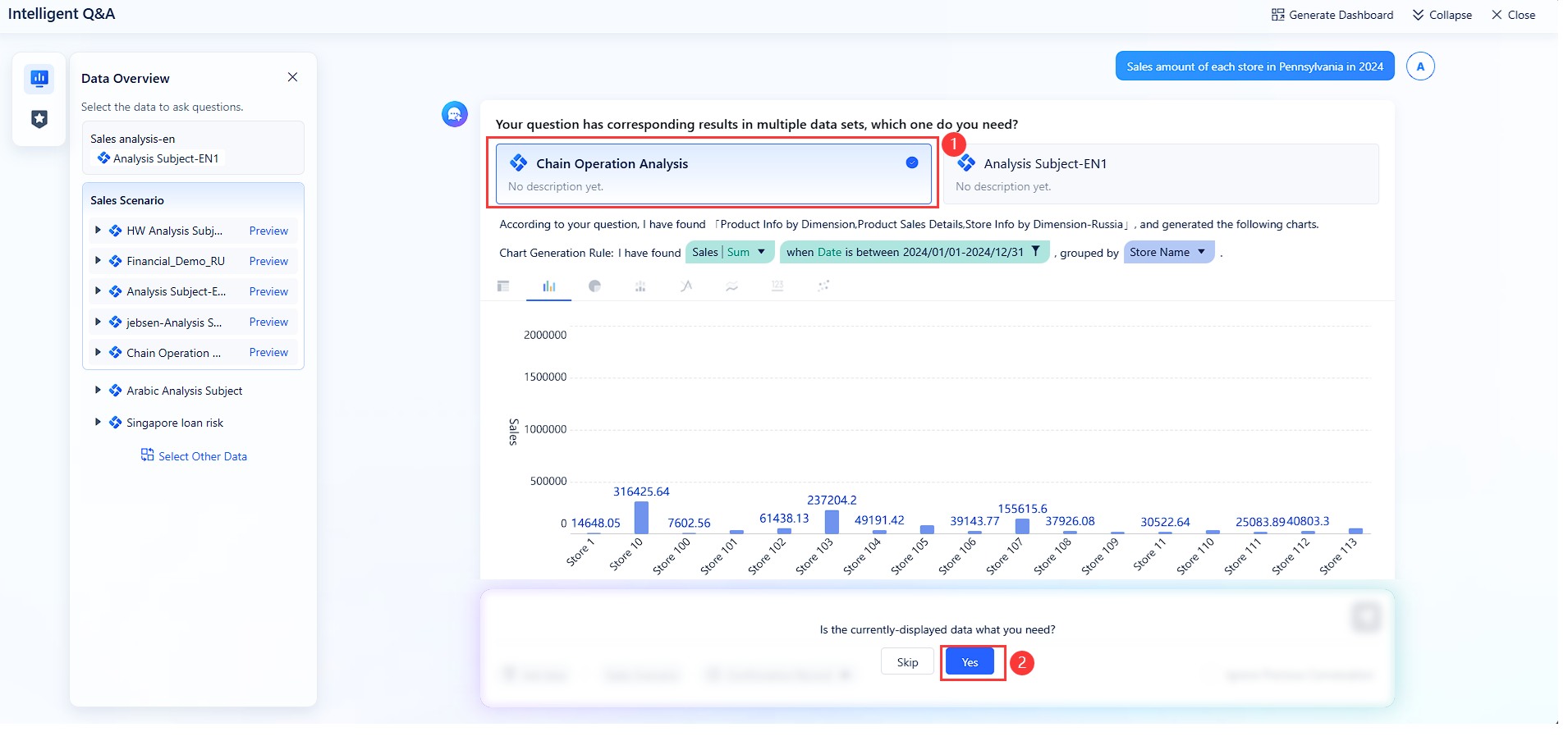
Note: FanRuan’s solutions give you the confidence to use big data in the age of ai for strategic growth.
Challenges and Solutions in Big Data Integration
Data Quality Issues
You face many data quality challenges when you work with big data in the age of ai. Poor data quality can lead to wrong decisions and wasted resources. Common issues include dormant customer data, unused log files, inaccurate or hidden data, duplicates, incomplete records, and inconsistent formats. These problems can slow down your ai and big data projects.
| Data Quality Issue | Examples and Impact |
|---|---|
| Dormant customer data | Increases costs and reduces data utilization. |
| Unused log files | Causes data silos and compliance risks. |
| Inaccurate data | Leads to wrong business intelligence and poor decisions. |
| Hidden data | Results in missed opportunities and weak analysis. |
| Duplicate data | Makes datasets unreliable and hard to integrate. |
| Incomplete data | Limits the depth of your analysis and can mislead insights. |
| Inconsistent data | Creates problems when merging data from different sources. |
| Ambiguous data | Causes confusion and errors in interpretation. |
| Data downtime | Complicates migration and analysis. |
| Human error | Introduces mistakes through typos and inconsistent entry. |
| Lack of validation | Reduces overall data quality and complicates management. |
| Conflicting formats | Causes errors during aggregation and analysis. |
| Incorrect attribution | Misguides marketing and sales strategies. |
You can improve data quality by using data contracts, enforcing unique identifiers, and making sure all fields are complete. FanRuan’s FineDataLink helps you standardize and validate data, reducing errors and improving overall quality for your ai and big data initiatives.
Bias and Fairness in AI
Bias in ai models can affect the fairness of your results. You need to address this challenge to build trust in your ai and big data systems. You can reduce bias by diversifying your teams and data sources. Oversight and governance help you stay accountable. Ethical frameworks, such as IEEE Standards and EU AI Ethics Guidelines, guide you in building fair ai systems.
A diverse team helps you spot hidden biases. You should also use structured approaches to review your ai models. FanRuan’s FineChatBI supports transparency by letting you see how the system interprets your queries, which helps you identify and fix bias in your big data analysis.

Regulatory Compliance
You must follow strict rules when you use big data and ai. Regulatory compliance protects privacy and ensures ethical use of data. Big data often comes in unstructured formats, which makes classification and security harder. Security risks increase with delayed threat detection and cross-border data flows.
To stay compliant, you should:
- Align ai integration with your data governance goals.
- Conduct Privacy Impact Assessments to protect privacy rights.
- Use ethical frameworks for responsible ai.
- Encourage teamwork between data governance and ai teams.
FanRuan’s FineDataLink helps you manage data securely and supports compliance with privacy laws. FineChatBI gives you clear audit trails, making it easier to track data use and meet regulatory standards.
Scalability and Performance
As your data grows, you need systems that scale and perform well. Modern technologies help you overcome these challenges in ai and big data projects.
| Strategy/Technology | Description |
|---|---|
| Microservices architecture | Breaks systems into smaller parts for better scaling. |
| Serverless computing | Adjusts resources automatically based on demand. |
| Containerization and orchestration | Packages and manages applications for consistency and easy scaling. |
| Distributed data stores | Uses NoSQL and distributed files to handle large data volumes. |
| Load balancing and CDN networks | Spreads traffic to keep systems fast and responsive. |
| Big Data processing frameworks | Tools like Hadoop and Spark process large datasets efficiently. |
FanRuan’s FineDataLink supports real-time data synchronization and ETL, making it easy to scale your big data operations. FineChatBI delivers fast, reliable insights, even as your data grows.
Tip: Addressing these challenges early helps you get the most value from ai and big data while maintaining high quality and compliance.
Future Outlook: AI and Big Data Opportunities
As you look to the future, you will see new technologies and strategies shaping how you use big data and ai. The landscape will keep changing, and you need to stay ready for new opportunities. Big data in the age of ai will continue to transform how you work, make decisions, and create value.
Emerging Technologies
You will see several new technologies that will change how you use ai and big data. These innovations will help you solve problems faster and open new doors for your business.
| Technology | Description |
|---|---|
| Generative AI | This technology will boost creativity and automation. You will use it to generate new data and improve analysis in many fields. |
| Collaborative Sensing | Networked sensors will help you monitor cities and the environment. Ai will use this data to support better decisions and improve daily life. |
| Nanozymes | These lab-made nanomaterials act like enzymes but cost less and last longer. You will see them in healthcare and environmental safety, changing how you analyze health data. |
Staying Ahead in 2025
You need to take action to stay ahead as ai and big data evolve. Here are some strategies you can use:
- Reskill your team by finding skill gaps and offering training in digital and soft skills.
- Build a strong data architecture to support high-quality ai applications.
- Foster a culture of continuous improvement with regular feedback and updates to ai systems.
- Encourage teamwork between people and ai to boost creativity and productivity.
- Follow ethical ai standards to ensure your systems are fair and transparent.
Actionable Recommendations
You can unlock more value from ai and big data by following these recommendations:
- Integrate ai and machine learning to improve predictions and automate data tasks.
- Use real-time data processing for instant decisions and better customer experiences.
- Adopt edge computing to reduce delays and protect data privacy.
- Make data privacy and security a top priority to build trust.
- Explore Data-as-a-Service for flexible and cost-effective data access.
- Use multi-cloud strategies for flexibility and risk management.
- Focus on data quality and governance to ensure accuracy and compliance.
- Try augmented analytics to make data insights available to everyone.
Tip: Invest in advanced solutions like FanRuan to help you adapt quickly and lead in the world of ai and big data.
You see big data in the age of ai driving new opportunities for business growth. Advanced data integration and ai-driven analytics help you make smarter decisions and improve outcomes. Companies using ai and big data report higher conversion rates, better customer connections, and increased revenue. You benefit from unified customer profiles and proactive insights. FanRuan’s solutions give you the tools to unlock these advantages. Start adopting innovative data strategies to stay ahead in a changing world.
- AI-driven predictive analytics boost conversion rates and marketing efficiency.
- Data integration creates unified profiles, improving decision-making and operational results.
- Personalization leads to deeper customer relationships and better outcomes.
Tip: Explore FanRuan’s platform to elevate your business with data-driven insights.
FAQ

The Author
Howard
Data Management Engineer & Data Research Expert at FanRuan
Related Articles

How Ai in Business Report is Shaping Enterprise Strategies
AI in business report reveals trends driving enterprise strategies, with rising adoption, agentic ai, and tools like FineChatBI boosting growth.
Lewis
Dec 21, 2025

What Is AI Data Analysis in 2025
AI data analysis in 2025 uses machine learning and NLP to process data, uncover patterns, and deliver fast, accurate insights for smarter decisions.
Lewis
Dec 18, 2025

The 10 Best AI Data Tools Every Analyst Should Know
See which AI data tools for 2025 help analysts automate tasks, boost productivity, and uncover insights with advanced analytics and seamless integration.
Lewis
Dec 17, 2025
